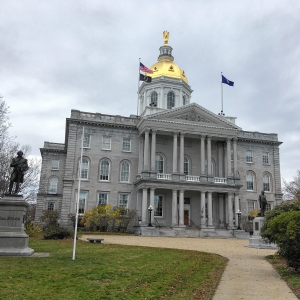Opinion: Witnessing autumn and winter wildlife
| Published: 12-17-2023 7:00 AM |
Terry Cronin lives in Hopkinton.
After autumn’s flash of color and foliage falls, the lay of the woodland in the Capital Region opens in rich relief. At the end of the season, migrating birds have gone south, and only year-round wildlife remains. With leaf blowing done, a given quiet graces all outdoors.
One day in early November I opened the shade of an upstairs window and saw six tufted titmice feeding on something in the moss on the porch roof below. Within minutes a blue jay flew in robbing the smaller birds of their find. Seconds afterward a red-bellied woodpecker plunged into view, driving the jay off the spoils.
Two days later, from a downstairs window, I startled some dark-eyed juncos subsisting in the wilds of my front yard. In an instant I knew them by the white stripes of their tails when they took to the air from the ground. According to my Audubon Field Guide, their upper bodies are slate-gray or gray-brown and “sharply demarcated” from their white abdomen. Juncos are easy to notice this time of year.
Weather depending, late in autumn and through winter they will feed on what looks like nothing on top of the snow.
The first bird feeder I bought was designed for a window but within weeks a thieving red squirrel destroyed it. My next purchase came fortified against marauding hoarders. For feed, I used sunflower seeds.
That winter, while chickadees, titmice and nuthatches bickered for turns at the feeder, a northern shrike showed up as if out of the Canadian blue. They are about ten inches long, light gray on top of their bodies, white on the bottom with a bold black mask and black on the wings and tail. And odd for songbirds, they prey on small birds and rodents.
For less than a week, the shrike took to the same dead tree limb nearby. Then one day, it dropped from its perch into a glide on a perfect line just above the ground and stopped under the feeder. It flew up and away, a limp mouse in its grasp. Blood from the killing froze in the snow. This was a grave yet ordinary spectacle.
Article continues after...
Yesterday's Most Read Articles
 Concord solidifies plan to respond to homelessness
Concord solidifies plan to respond to homelessness
 Lawyers and lawmakers assert the Department of Education is on the verge of violating the law
Lawyers and lawmakers assert the Department of Education is on the verge of violating the law
 A May tradition, the Kiwanis Fair comes to Concord this weekend
A May tradition, the Kiwanis Fair comes to Concord this weekend
 Despite using federally funded math coaches, Concord math scores show little improvement
Despite using federally funded math coaches, Concord math scores show little improvement
 Concord planning board approves new casino zoning
Concord planning board approves new casino zoning
 On the trail: Biden back to N.H. next week
On the trail: Biden back to N.H. next week
All these wildlife survival dramas happened while I watched from the windows indoors.
In the woods behind my house, years of yard work gave rise to a huge brush pile. Once during winter, I set a feeder attached to a pole in it. Birds and squirrels came for the seeds throughout the day.
One cold afternoon, my son tried to tame some chickadees. He did this by offering a few seeds from his hand while pressing down on the feeder’s weighted perch, thwarting the birds from its bounty. After a few minutes, he called me to see something.
At the scene, he stood amid a maelstrom of chickadees and nuthatches unwilling to trust him. But, on the ground two of the tiniest mammals I’ve ever seen emerged from the decaying brush heap at his feet. After a few seconds, I recognized them from my other Audubon guide; they were pygmy shrews. The couple we saw were grayish, a breathtaking size about 1.5 inches long. They are the smallest and rarest mammal in North America, “weighing no more than a dime.”
The chickadees dwarfed them.
In the field, pygmy shrews are elusive and not much is known of their behavior. The National Wildlife Foundation says, “Their speed of life defies imagination.”
We saw them rummaging through the residue on the inside of sunflower seed hulls.
What virtue is there in watching wildlife? What is the worth in seeing, for example, the golden-crowned kinglet, a three-and-a-half-inch winter visitor, insectivores, adept at finding hibernating insects in twigs and bark?
In winter’s deep freeze, their lives and their beauty also defy imagination.







 Opinion: Never again to anyone
Opinion: Never again to anyone Opinion: What it means to be an American
Opinion: What it means to be an American Opinion: Looking forward to resting in motion
Opinion: Looking forward to resting in motion Opinion: Technology and the human brain
Opinion: Technology and the human brain
